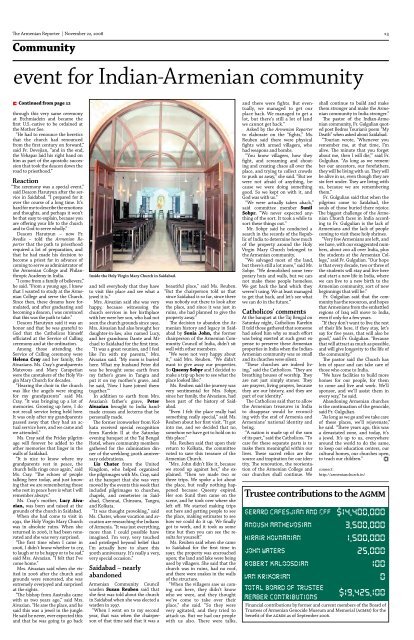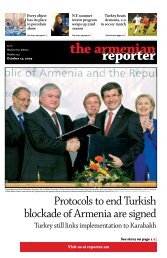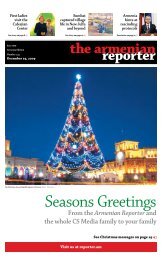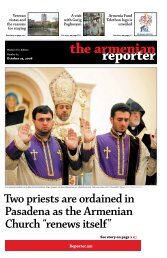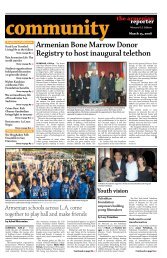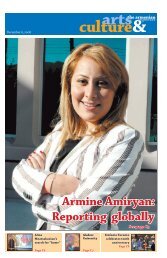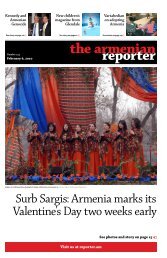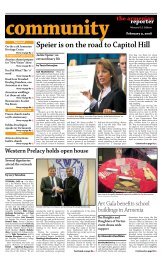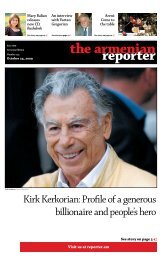And for this we are thankful.... - Armenian Reporter
And for this we are thankful.... - Armenian Reporter
And for this we are thankful.... - Armenian Reporter
You also want an ePaper? Increase the reach of your titles
YUMPU automatically turns print PDFs into web optimized ePapers that Google loves.
The <strong>Armenian</strong> <strong>Reporter</strong> | November 22, 2008 13Communityevent <strong>for</strong> Indian-<strong>Armenian</strong> community Continued from page 12through <strong>this</strong> very same ceremonyat Etchmiadzin and became thefirst U.S.-native to be ordained atthe Mother See.“He had to renounce the hereticsthat the church had renouncedfrom the first century on <strong>for</strong>ward,”said Fr. Devejian, “and in the end,the Vehapar laid his right hand onhim as part of the apostolic successionthat took the deacon down theroad to priesthood.”Reaction“The ceremony was a special event,”said Deacon Harutyun after the servicein Saidabad. “I prep<strong>are</strong>d <strong>for</strong> itover the course of a long time. It’shard <strong>for</strong> me to describe the emotionsand thoughts, and perhaps it won’tbe that easy to explain, because you<strong>are</strong> offering your life to the churchand to God to serve wholly.”Deacon Harutyun – now Fr.Avedis – told the <strong>Armenian</strong> <strong>Reporter</strong>that the path to priesthoodrequired a lot of preparation, andthat he had made his decision tobecome a priest far in advance ofcoming to serve as administrator ofthe <strong>Armenian</strong> College and PhilanthropicAcademy in India.“I come from a family of believers,”he said. “From a young age, I knewthat I wanted to study at the <strong>Armenian</strong>College and serve the Church.Since then, these dreams have <strong>for</strong>mulated,and after graduating andbecoming a deacon, I was convincedthat <strong>this</strong> was the path to take.”Deacon Harutyun said it was anhonor and that he was grateful toGod that the Catholicos himselfofficiated at the Service of Callingceremony and at the ordination.Among those attending theService of Calling ceremony <strong>we</strong>reHelena Cray and her family, theAivazians. Ms. Cray’s grandp<strong>are</strong>ntsMatevous and Mary Carapetian<strong>we</strong>re the c<strong>are</strong>takers of the Holy VirginMary Church <strong>for</strong> decades.“Hearing the choir in the churchwas like the angels <strong>we</strong>re singing<strong>for</strong> my grandp<strong>are</strong>nts” said Ms.Cray. “It was bringing up a lot ofmemories. Growing up here, I donot recall service being held here.It was only after my grandp<strong>are</strong>ntspassed away that they had an actualservice here, and <strong>we</strong> came and<strong>we</strong> attended.”Ms. Cray said the Friday pilgrimagewill <strong>for</strong>ever be added to theother memories that linger in thewalls of Saidabad.“It is nice to know where mygrandp<strong>are</strong>nts rest in peace, thechurch bells rings once again,” saidMs. Cray. “The echoes of peopletalking here today, and just knowingthat <strong>we</strong> <strong>are</strong> remembering thosewho rest in peace here is what I willremember always.”Ms. Cray’s mother, Lucy Aivazian,was born and raised at thegrounds of the church in Saidabad.When she had come to visit in1991, the Holy Virgin Mary Churchwas in absolute ruins. When shereturned in 2006, it had been renovatedand she was very surprised.“The first time when I came in2006, I didn’t know whether to cry,to laugh or to be happy or to be sad,”said Mrs. Aivazian. “I felt that I’vecome home.”Mrs. Aivazian said when she visitedin 2006 after the church andgrounds <strong>we</strong>re renovated, she wasextremely overjoyed and surprisedat the sights.“The bishop from Australia camewith us two years ago,” said Mrs.Aivazian. “He saw the place, and hesaid <strong>this</strong> was a je<strong>we</strong>l in the jungle.He said he never, ever expected <strong>this</strong>and that he was going to go backInside the Holy Virgin Mary Church in Saidabad.and tell everybody that they haveto visit <strong>this</strong> place and see what aje<strong>we</strong>l it is.”Mrs. Aivazian said she was veryhappy, because witnessing thechurch services in her birthplacewith her <strong>we</strong>re her son, who had notseen the church grounds since 1991.Mrs. Aivasian had also brought herdaughter-in-law, also named Lucy,and her grandsons Dante and Michaelto Saidabad <strong>for</strong> the first time.“It was a great reunion, and I feellike I’m with my p<strong>are</strong>nts,” Mrs.Aivazian said. “My mom is buriedhere. What my husband Peter didwas he brought some earth frommy father’s grave in Tangra andput it on my mother’s grave, andhe said, ‘Now I have joined themtogether.’”In addition to earth from Mrs.Avazian’s father’s grave, PeterAivazian brought to India handmadecrosses and lecterns that hepersonally made.The <strong>for</strong>mer ironworker from Kolkat<strong>are</strong>ceived special recognitionfrom K<strong>are</strong>kin II at the Saturdayevening banquet at the Taj BengalHotel, where community membersgathered <strong>for</strong> the culmination dinnerof the <strong>we</strong>eklong 300th anniversarycelebrations.Liz Chater from the UnitedKingdom, who helped organizedthe pilgrimages with Ms. Cray, saidat the banquet that she was verymoved by the events <strong>this</strong> <strong>we</strong>ek thatincluded pilgrimages to churches,chapels, and cemeteries in Saidabad,Chennai, Chinsura, Tangra,and Kolkata.“It was thought provoking,” saidMs. Chater, whose vocation and avocation<strong>are</strong> researching the Indiansof Armenia. “It was just everything,more than I could possible haveimagined. I’m very, very touchedand privileged beyond belief thatI’m actually here to sh<strong>are</strong> <strong>this</strong>300th anniversary. It’s really a very,very special occasion.”Saidabad – nearlyabandoned<strong>Armenian</strong> Community Councilwarden Susan Reuben said thatshe first was told about the churchin Saidabad when she was elected awarden in 1997.“When I <strong>we</strong>nt on to my secondyear, that was when the chairpersonof that time said that it was abeautiful place,” said Ms. Reuben.“But the chairperson told us thatsince Saidabad is so far, since therewas nobody out there to look afterthe place, and since it was just inruins, she had planned to give theproperty away.”The decision to abandon the <strong>Armenian</strong>history and legacy in Saidabadby Sonia John, the <strong>for</strong>merchairperson of the <strong>Armenian</strong> CommunityCouncil of India, didn’t sit<strong>we</strong>ll with other members.“We <strong>we</strong>re not very happy aboutit,” said Mrs. Reuben. “We didn’twant to give away our properties.So Queeny Sobpr and I decided tomake a trip up here to see what theplace looked like.”Ms. Reuben said the journey wasvery sentimental <strong>for</strong> Mrs. Sobpr,since her family, the Aivazians, hadbeen part of the history of Saidabad.“Even I felt the place really hadsomething really special,” said Ms.Reuben about her first visit. “It gotinto me, and <strong>we</strong> decided that no,somehow <strong>we</strong> have got to hold on to<strong>this</strong> place.”Ms. Reuben said that upon theirreturn to Kolkata, the committeevoted to save <strong>this</strong> treasure of the<strong>Armenian</strong> Church.“Mrs. John didn’t like it, because<strong>we</strong> stood up against her,” she explained.“Then <strong>we</strong> made two orthree trips. We spoke a lot aboutthe place, but really nothing happenedbecause Queeny expired.Her son Sunil then came on thescene, and he took over where sheleft off. We started making tripsout here and getting people to seethe place, making estimates to seehow <strong>we</strong> could do it up. We finallygot to work, and it took us sometime but then you can see the results<strong>for</strong> yourself.”Ms. Reuben said when she cameto Saidabad <strong>for</strong> the first time in1997, the property was encroachedupon; the land and lake <strong>we</strong>re beingused by villagers. She said that thechurch was in ruins, had no roof,and there <strong>we</strong>re snakes in the wallsof the structure.“When the villagers saw us comingout here, they didn’t knowwho <strong>we</strong> <strong>we</strong>re, and they thought<strong>we</strong>’ve come to take over theirplace,” she said. “So they <strong>we</strong>revery agitated, and they tried toattack us. But <strong>we</strong> had our peoplewith us also. There <strong>we</strong>re talks,and there <strong>we</strong>re fights. But eventually,<strong>we</strong> managed to get ourplace back. We managed to get alot, but there’s still a lot of land<strong>we</strong> cannot get back.”Asked by the <strong>Armenian</strong> <strong>Reporter</strong>to elaborate on the “fights,” Ms.Reuben said there <strong>we</strong>re physicalfights with armed villagers, whohad <strong>we</strong>apons and bombs.“You know villagers, how theyfight, and screaming and shoutingand creating chaos all over theplace, and trying to collect crowdsto push us away,” she said. “But <strong>we</strong><strong>we</strong>re not afraid of anything, because<strong>we</strong> <strong>we</strong>re doing somethinggood. So <strong>we</strong> kept on with it, andGod was with us.”“We <strong>we</strong>re actually taken aback,”said committee member SunilSobpr. “We never expected anythingof the sort. It took a while tosort these things out.”Mr. Sobpr said he conducted asearch in the records of the Republicof India to determine how muchof the property around the HolyVirgin Mary Church belonged tothe <strong>Armenian</strong> community.“We salvaged most of the land,but there’s still a lot more,” said Mr.Sobpr. “We demolished some temporaryhuts and walls, but <strong>we</strong> cannotmake these people homeless.We got back the land which they<strong>we</strong>ren’t using. We at least managedto get that back, and let’s see what<strong>we</strong> can do in the future.”Catholicos’ commentsAt the banquet at the Taj Bengal onSaturday night, Catholicos K<strong>are</strong>kinII told those gathered that someonehad asked him why so much ef<strong>for</strong>twas being exerted at such great expenseto preserve these <strong>Armenian</strong>properties in India when the Indian-<strong>Armenian</strong> community was so smalland its churches <strong>we</strong>re silent.“These churches <strong>are</strong> indeed living,”said the Catholicos. “They <strong>are</strong>breathing houses of worship. They<strong>are</strong> not just simply stones. They<strong>are</strong> prayers, living prayers, becausethey <strong>are</strong> our history, and they <strong>are</strong>part of our identity.”The Catholicos said that to allowthe <strong>Armenian</strong> treasures in Indiato disappear would be reconcilingwith the end of Armenia and<strong>Armenian</strong>s’ national identity andbeing.“A nation is made up of the sumof its part,” said the Catholicos. “Toc<strong>are</strong> <strong>for</strong> these separate parts is tomake them meaningful within ourlives. These sacred relics <strong>are</strong> thesource and inspiration <strong>for</strong> our identity.The renovation, the reorientationof the <strong>Armenian</strong> College andour churches shall continue. Weshall continue to build and makethem stronger and make the <strong>Armenian</strong>community in India stronger.”The pastor of the Indian-<strong>Armenian</strong>community, Fr. Gulgulian quotedpoet Bedros Tourian’s poem “MyDeath” when asked about Saidabad.“Tourian wrote, ‘Whenever youremember me, at that time, I’malive. The minute that you <strong>for</strong>getabout me, then I will die,’” said Fr.Gulgulian. “As long as <strong>we</strong> rememberour ancestors, our <strong>for</strong>efathers,they will be living with us. They willbe alive in us, even though they <strong>are</strong>six feet under. They <strong>are</strong> living withus, because <strong>we</strong> <strong>are</strong> rememberingthem.”Fr. Gulgulian said that when thepilgrims come to Saidabad, thesouls of those buried there rejoice.The biggest challenge of the <strong>Armenian</strong>Church faces in India accordingto Fr. Gulgulian is the lack of<strong>Armenian</strong>s and the lack of peoplecoming to visit these holy shrines.“Very few <strong>Armenian</strong>s <strong>are</strong> left, and<strong>we</strong> have, with our exaggerated numbers,about 200 all over India, plusthe students at the <strong>Armenian</strong> College,”said Fr. Gulgulian. “Our hopeis that every decade, two or three ofthe students will stay and live hereand start a new life in India, where<strong>we</strong> can live to a new birth to the<strong>Armenian</strong> community, sort of newbeginnings that will be.”Fr. Gulgulian said that the communityhas the resources, and hopesthat <strong>Armenian</strong>s from the embattledregions of Iraq will move to India,even if only <strong>for</strong> a few years.“If they don’t want to live the restof their life here, if they stay, let’ssay <strong>for</strong> five years, that will also begood,” said Fr. Gulgulian. “Becausethat will attract as much as possible,and will give longevity to the life ofthe community.”The pastor said the Church haslots of space and can take c<strong>are</strong> ofthose who come to India.“We have facilities to build morehomes <strong>for</strong> our people, <strong>for</strong> themto come and live and work. We’llsponsor, and <strong>we</strong>’ll assist them inevery way,” he said.Abandoning <strong>Armenian</strong> churchesis the continuation of the genocide,said Fr. Gulgulian.“As long as <strong>we</strong> go and <strong>we</strong> take c<strong>are</strong>of these places, <strong>we</strong>’ll rejuvenate,”he said. “Three years ago, <strong>this</strong> wasa devastated zone, and today, it’sa je<strong>we</strong>l. It’s up to us, everywherearound the world to do the same,to keep our education centers, ourcultural homes, our churches open,to teach our children.” connect:http://armenianchurch.in/Trustee contributions to the agmmFinancial contributions by <strong>for</strong>mer and current members of the Board ofTrustees of <strong>Armenian</strong> Genocide Museum and Memorial (agmm) <strong>for</strong> thebenefit of the agmm as of September 2006.


